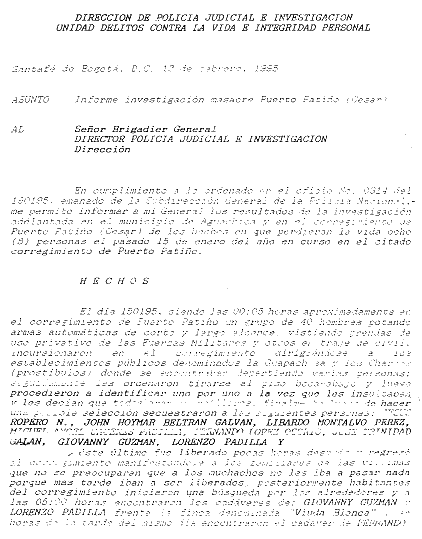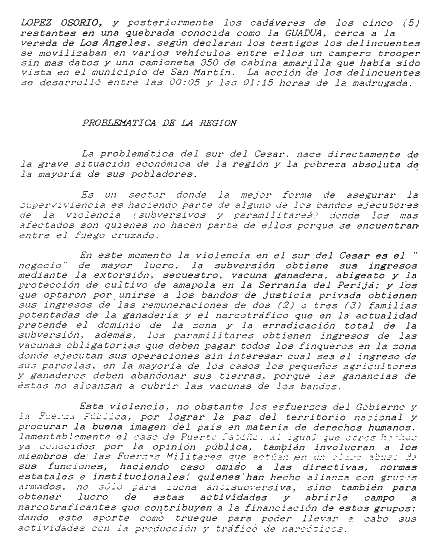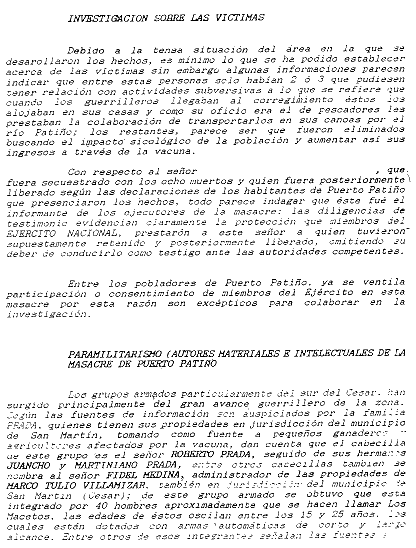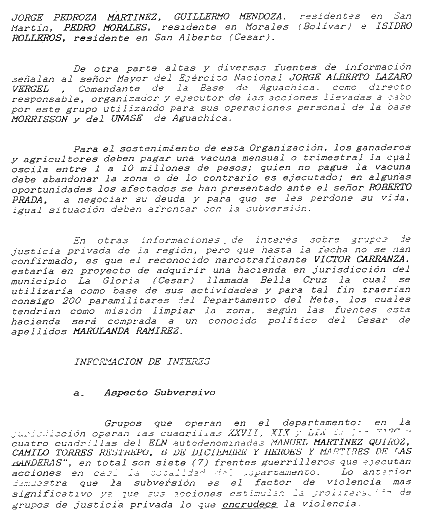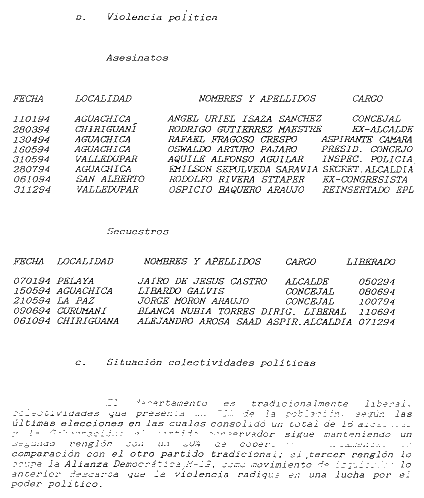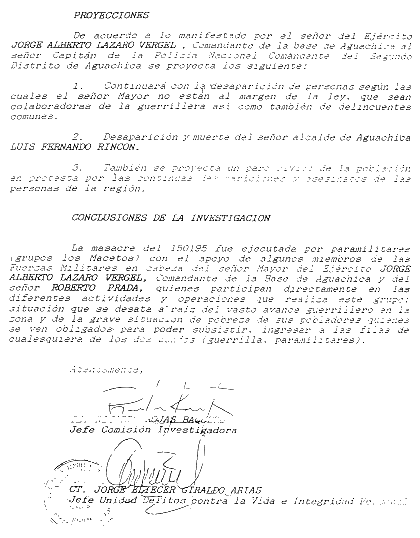






APPENDIX B (ENGLISH TRANSLATION FROM THE ORIGINAL)
Colombian Police Report on the Puerto Patiño massacre of 1/95
Colombian Police Report on the Puerto Patiño massacre of January 1995 (Dirección de Policía Judicial e Investigación, Unidad Delitos Contra la Vida e Integridad Personal, Santafé de Bogotá, 12 de febrero, 1995, "Informe investigación masacre Puerto Patiño").
JUDICIAL AND INVESTIGATIVE POLICE UNIT FOR CRIMES AGAINST LIFE AND PERSONAL INTEGRITY
Santafe de Bogota, February 13, 1995
RE: Report on massacre at Puerto Patiño (Cesar)
TO: Brigadier General
DIRECTOR OF THE JUDICIAL AND INVESTIGATIVE POLICE
Office
Pursuant to the order in official communication No. 0314 of January 19, 1995, from the Office of the Deputy Director of the National Police, I take this opportunity to inform you, General, of the results of the investigation undertaken in the municipality of Aguachica and in the district of Puerto Patiño (Cesar) to look into the events in which eight (8) persons lost their lives on January 15, 1996, in Puerto Patiño.
THE FACTS
On January 15, 1995, at approximately 5:00 a.m., in the district of Puerto Patiño,a group of 40 men carrying short nd long-range automatic weapons, some wearing uniforms restricted for the use of the Military Forces and others in civilian dress, entered the district and went to the public establishments known as La Guapachosa and Los Charcos (brothels) where various people were socializing; they ordered everyone to lie face down; they proceeded to identify them one by one, while insulting them and telling them that they were all guerrillas. Finally, possibly after making a selection, they kidnapped the following people: JESUS ROPERO N., JOHN HOYMAR BELTRAN GALVAN, LIBARDO MONTALVO PEREZ, MIGUEL ANGEL CACERES PADILLA, FERNANDO LOPEZ OSORIO, JOSE TRINIDAD GALAN, GIOVANNY GUZMAN, LORENZO PADILLA, AND [the informant Jos&ecute;]; The last of the aforementioned was released a few hours later and returned to the district, where he told the victims' relatives not to worry, that nothing was going to happen to the boys, because they would be released later. Some time thereafter inhabitants of the district began a search of the surrounding area, and at 5:00 a.m. they found the corpses of GIOVANNY GUZMAN and LORENZO PADILLA at the entrance the farm known as "White Widow": that afternoon, they found the corpse of FERNANDO LOPEZ OSORIO, and later the corpses of the other five (5) in a brook known as LA GUADUA, near the village of Los Angeles. According to the testimony of witnesses, the criminals moved about in several vehicles, including a Trooper camper, with no other data, and a 350 yellow-cabin pick-up truck that had been seen in the municipality of San Martin. The actions perpetrated by the criminals were carried out from 12:05 a.m. to 1: 15 a.m.
SITUATION IN THE REGION
The problems in southern Cesar are born directly from the grave economic situation in the region and the absolute poverty of the majority of its population.
In a sector where the best way to guarantee one's survival is to join one of the bands carrying out violence (subversives or paramilitaries), the hardest hit are those who don't take sides, but who find themselves in the cross-fire.
At this time, violence in southern Cesar is the most profitable "business." The subversives obtain income from extortion, kidnappings, payment of protection money, cattle-rustling, and to protect poppy fields in the Serran´a del Perijá. Those who opt to ally themselves with bands of private justice obtain their income from the remunerations of two (2) or three (3) powerful families involved in cattle ranching and narcotics trafficking, who are now trying to dominate the zone and eradicate all the subversion. Futhermore, the paramilitaries obtain income from the obligatory payments that all farmers [small and large] must pay regardless of the income earned on their parcels. In most cases, the small farmers and ranchers must abandon their lands, as their earnings are not enough to cover the payments extorted by [both] bands.
Despite the efforts of the government and its security forces to achieve national peace and further a good image for the country with respect to human rights, unfortunately, the case of Puerto Patiño, like other cases already known to public opinion, also involves members of the Military Forces who act in a manner clearly abusive of their authority, ignoring state and institutional directives and standards. They have entered into an alliance with armed groups not only for the counter-insurgency struggle, but also to profit from these activities and to open the way for narco-traffickers, who make financial contributions to these groups in exchange for being able to carry out the production and trafficking of narcotics.
INVESTIGATION INTO THE VICTIMS
Due to the tense situation in the area where the events occurred, very little has been determined about the victims. Even so, some information indicates only two or three of these people may have had some connection to subversive activities, meaning that when the guerrillas came to the district they kept them in their homes, and since they were fishermen, they transported them in their canoes along Patiño River. The rest, it seems, were eliminated in order to have a psychological impact on the population, and thereby compel them to pay the protection money.
Concerning [the informant José], who was kidnapped along with the eight victims but who was later freed, testimony from inhabitants who witnessed the events strongly suggests that he was the informant for the perpetrators of this massacre. The testimony clearly shows the protection that members of the NATIONAL ARMY have given this man, who they had supposedly detained and then released, and so have failed in their duty to bring him, as a witness, before the competent authorities.
People in Puerto Patiño, who have already seen the participation or consent of members of the Army in this massacre, have been, for that reason, reluctant to collaborate with this investigation.
PARAMILITARISM (MATERIAL AND INTELLECTUAL AUTHORS OF THE PUERTO PATIÑO MASSACRE)
The armed groups, especially in southern Cesar, have arisen mainly in response to the major strides the guerrilla movement has made in the zone. According to sources, [the armed groups] are supported by the PRADA family, which owns properties in the jurisdiction of the municipality of San Martín; these sources are small-scale ranchers and farmers who are forced to pay protection money. They state that the leader of this group is Mr. ROBERTO PRADA, followed by his brothers JUANCHO and MARTINIANO PRADA; among other leaders also mentioned was Mr. FIDEL MEDINA, administrator of the properties of MARCO TULIO VILLAMIZAR, also in the jurisdiction of the municipality of San Martín (Cesar). It was found that this armed group is made up of approximately 40 men who call themselves Los Macetos; they range in age from 15 to 25 years. They have automatic short- and long-range weapons. The sources indicate that their members include JORGE PEDROZA MARTINEZ, GUILLERMO MENDOZA, residents of San Martin, PEDRO MORALES, resident in Morales (Bolivar), and ISIDRO ROLLEROS, a resident of San Alberto (Cesar).
Furthermore, high-level and diverse sources of information indicate that National Army Major JORGE ALBERTO LAZARO VERGEL, Commander of the Aguachica Base, was directly responsible for and directly involved in organizing and carrying out the actions of this group, using personnel from the MORRISSON base of UNASE [Anti-kidnapping and Extortion Unit, a government security force] in Aguachica.
To support this Organization, the ranchers and farmers must pay monthly or quarterly protection money that ranges from 1 million to 10 million pesos. Those who don't pay the protection money must leave the zone, or else they are executed. On some occasions the persons affected have come before Mr. ROBERTO PRADA to negotiate their debt, and to beg mercy for their lives; they must do the same vis-á-vis the subversion.
Other information of interest regarding private justice groups in the region, but which has yet to be confirmed, has it that the well-known narco-trafficker VICTOR CARRANZA is planning to acquire an estate in the jurisdiction of the municipality of La Gloria (Cesar) known as Bella Cruz, which he would use as a base for his activities, for which he would bring in 200 paramilitary operatives from the department of Meta whose mission would be to clean up the zone. According to the sources this estate is to be purchased from a well-known politician from Cesar whose last names are MARULANDA RAMIREZ.
INFORMATION OF INTEREST
a. The Subversives
Groups that operate in the department: the XXVII, XIX, and LIX fronts of the FARC and four ELN fronts known by the names MANUEL MARTINEZ QUIROZ, CAMILO TORRES RESTREPO, 6TH OF DECEMBER, and HEROES AND MARTYRS OF LAS BANDERAS all operate in the jurisdiction, for a total of seven (7) guerrilla fronts that carry out actions practically throughout the entire department. This demonstrates that the subversion is the most significant factor of violence, as its actions encourage the proliferation of private justice groups, which worsens the violence.
b. Political violence
Assassinations
DATE LOCALITY FULL NAME POSITION 1/1/94 Aguachica Angel Uriel Isaza Sánchez Councilman 3/28/94 Chiriguaní Rodrigo Gutiérrez Maestre ex-mayor 4/13/94 Aguachica Rafael Fragoso Crespo Candidate to congress 5/16/94 Aguachica Oswaldo Arturo Pájaro Council chair 5/31/94 Valledupar Aquile Alfonso Aguilar Police inspect. 7/28/94 Aguachica Emilson Sepulveda Saravia Munic. Sec'y 10/6/94 San Alberto Rodolfo Rivera Sttaper Ex-congressman 12/31/94 Valledupar Ospicio Baquero Araujo Reinserted EPL
Kidnappings
DATE LOCALITY FULL NAME POSITION RELEASED 1/7/94 Pelaya Jairo de Jesús Castro Mayor 2/5/94 5/15/94 Aguachica Libardo Galvis Councilman 6/8/94 5/21/94 La Paz Jorge Morón Araujo Councilman 7/10/94 6/9/94 Curumaní Blanca Nubia Torres Liberal leader 6/11/94 10/6/94 Chiriguana Alejandro Arosa Saad Mayoral cand. 12/7/94
C. Status of political organizations
Traditionally the predominant political organization is the Liberal party, which enjoys the backing of 78% of the population, based on the last elections, in which the Liberal party consolidated its hold on the mayors' offices, bringing 16 mayors to office, and also electing the Governor. The Conservative party continues in second place with 20% of the votes in the department behind the other traditional party; the third strongest political party is the Democratic Alliance / M-19, a leftist movement. This shows that the violence is not based on a struggle for political power.
PROJECTIONS
Based on what was said by Arrny officer JORGE ALBERTO LAZARO VERGEL, Commander of the Aguachica base, to National Police Captain for the Second District of Aguachica, the following situation is anticipated:
I . The disappearance of people will continue. According to the Major [Lázaro], these disappearances are not illegal, as long as [the targets] are guerrilla collaborators or common delinquents.
2. Disappearance and death of the mayor of Aguachica, LUIS FERNANDO RINCON, [is also likely].
3. Also projected is a civic strike by the population to protest the continuing disappearances and assassinations of persons in the region.
CONCLUSIONS OF THE INVESTIGATION
The massacre of May 15, 1995 was carried out by paramilitaries (groups known as Los Macetos) with support from some members of the Military Forces under Army Major JORGE ALBERTO LAZARO VERGEL, the Aguachica base commander, and Mr. ROBERTO PRADA, both of whom directly participated in the various activities and operations carried out by this group. This situation has arisen in response to the major guerrilla advances in the zone, and the dire poverty of the inhabitants, who in order to survive must join the ranks of one of the two sides (guerrillas, paramilitaries).
Sincerely,
[signature]
RICARDO ROJAS BAQUERO
Chief, Investigative Commission
[signature]
Captain JORGE ELIECER GIRALDO ARIAS
Chief, Unit of Crimes Against Life and Personal Integrity
